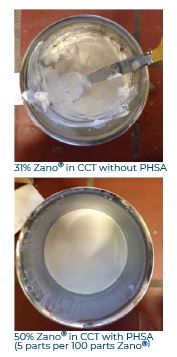Zano® 10, Zano® 20 & Zano® M
Dispersion
Proper dispersion is key to good performance for all Zano® products. Disperse Zano® and Zano® Plus preferably in the oil phase. Xperse® dispersions will result in optimal dispersion of Zano® or Zano® Plus by simply adding these to the oil phase – there is no need for further additives or milling.
Dispersion in esters and oils
Untreated Zano® and Zano® Plus can be dispersed in esters and oils. The surface treatment of Zano® Plus will allow for easier incorporation and dispersion. The use of a dispersing aid is highly recommended for better dispersion and long-term stability.

Dispersing aids and dosage in esters and oils
A preferred dispersing aid is Polyhydroxystearic acid (PHSA). A typical dosage is 4-5 parts of PHSA per 100 parts Zano® (Plus), but the exact required amount depends on the type of PHSA used. Suggested products are Dispersun DSP-OL100 and Dispersun DSP-OL300 (Innospec).
For each combination of Zano, ester/oil and dispersing aid, optimal dispersing aid levels need to be determined. The optimum level is where the viscosity of a dispersion is lowest and ladder studies need to be performed to determine this optimum.
Formulation steps
Zano® and Zano® Plus are preferably dispersed in the oil phase, but rather than mixing all oil phase ingredients at the same time, the following formulation steps are important to ensure good dispersion and maximum formulation stability :
- Start with an amount of ester or oil that is approximately equal to the amount of Zano® to be dispersed. If necessary, a blend of esters and oil can be used as well, although starting with one ester is preferred.
- Add the dispersing aid(s) and dissolve in the ester/oil. Do not add any other ingredients at this time. Apply heat to melt PHSA or pre-melt PHSA prior to addition.
- Add Zano® or Zano® Plus and disperse well. Continue until no visible lumps are present any longer.
- Only when step 3 is complete, add the other ingredients of the oil phase and mix.
- Prepare water phase and emulsify.
Dispersion in silicone oils
Untreated Zano® and Zano® Plus can be used in silicone oils. The formulation guidelines and steps given for esters above are valid for silicone oils as well. The suggested dispersing aids are different however: PEG-10-dimethicone or other PEG/PPG/silicone oil products. Recommended dosage is 10-15 parts per 100 parts Zano® (Plus), depending on the product used. Zano® and Zano® Plus are compatible with most emulsifiers, especially non-ionics.
Emulsifiers and thickeners
Zano® and Zano® Plus are highly compatible with non-ionic thickeners, such as Xanthan gum and Veegum. When using Carbomer type thickeners, Zano® Plus is preferred. Newer types of carbomer thickeners are preferred as they are less sensitive to ions in a formulation, such as Carbopol® Aqua or Carbopol®Ultrez (Lubrizol). When using older versions of Carbomer type thickeners, it is suggested to neutralize the polymer prior to adding Zano® Plus.
| SPF 1% adds | UVA-PF 1% adds | UVA-PF/ SPF | Critical wavelength | Transparency | |
|---|---|---|---|---|---|
| Zano® 10 Zano® 10 Plus |
~1.6 units | ~0.75 units | ~0.5 | 373 nm | Very good |
| Zano® 20 Zano® 20 Plus |
~1.5 units | ~0.6 units | ~0.4 | 371 nm | Excellent |
| Zano® M Zano® M Plus |
~1.5 units | ~1.5 units | ~1.0 | 385 nm | Good |
SPF and UVA performance
The following is an indication of SPF and UVA performance for Zano® 10 (Plus), Zano® 20 (Plus) and Zano® M (Plus) when used as single UV filter:
pH
For uncoated Zano® target pH value of formulations is ~7, whereas it it is less critical for Zano® Plus. In general it is recommended to ensure good dispersion and stabilization in the oil phase to prevent pH changes in the water phase.
Mixing equipment
Zano® powders can be dispersed using high shear mixers, such as dissolver type mixers (also referred to as disperser or Cowles mixers). A homogenizer is not required, but may be used as well.

The Zano® products are manufactured by EverZinc. Ultra is the supplier of the Zano® products in the parts of the US and Canada.
